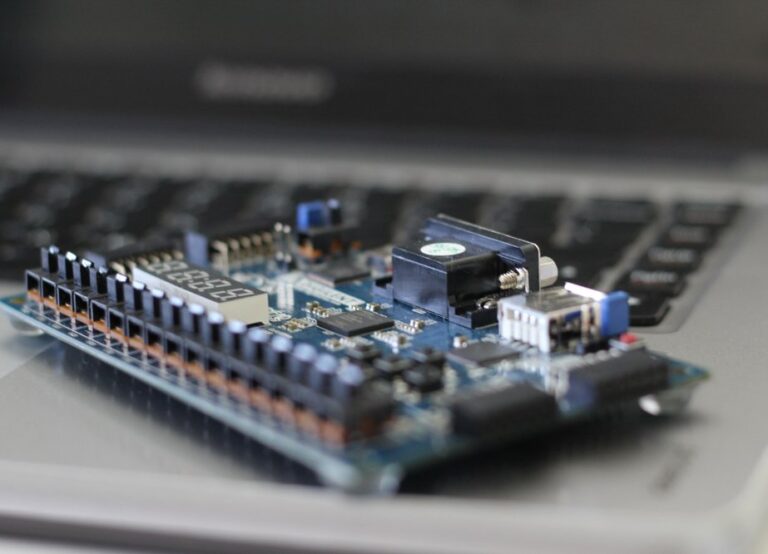
Unprecedented Performance with FPGA
In software programming, developers are accustomed to the versatility of general-purpose CPUs and the flexibility of software-based solutions. However, there’s a game-changer in the world of digital processing that you might not be familiar with – FPGAs, or Field Programmable Gate Arrays. Let’s explore what FPGAs are, why they matter, and how they can transform the landscape of high-performance computing.
What Are FPGAs?
A typical software compiles itself into binary machine code and is fed into a general purpose CPU to achieve the designed process. The CPU needs to read each command, run it through a set of circuits, and return the result. Now, imagine you can compile your code straight into a set of circuits rather than binary code – dropping the need for the CPU. This custom-built hardware will run your code without the need to interpret it, and deal very little with input/output.
FPGAs achieve this by offering an array of configurable logic blocks and programmable interconnects. This allows you to create custom digital circuits and perform specialized functions to get a processor capable of doing only one thing – your code.
At the heart of an FPGA lies a grid of configurable logic blocks (CLBs) and programmable interconnects. These CLBs are essentially small units that can be customized to perform specific logic functions, such as AND, OR, XOR, and more. You can use a special language such as VHDL or Verilog to describe the desired logic and interconnections between these CLBs. Your code synthesized into a configuration file that tells the FPGA how to route signals through its internal connections and what logic operations to perform.
Think of it as creating a blueprint for a digital circuit. Once this configuration file is loaded onto the FPGA, the device effectively becomes that custom digital circuit, capable of executing your specified operations at blazing speeds. The parallelism and ability to tailor the hardware to the task at hand is what makes FPGAs a powerful tool for a wide range of applications.
When to use FPGAs
So, why should software developers pay attention to FPGAs? Parallelism, machine learning, and low latency applications:
FPGAs excel at parallelism, or performing multiple operations simultaneously, making them ideal for tasks requiring high throughput and low latency. This quality is essential for real-time applications, such as image and video processing, scientific simulations, and cryptography.
FPGAs can speed up machine learning models to meet your real-time requirements via hardware acceleration. Imagine an FPGA that represents a machine learning model, making it crucial for deep learning and scientific computing.
If you’re working on applications that demand low latency, like high-frequency trading or network acceleration, FPGAs are a top choice. They deliver ultra-fast responses, ensuring your system operates at peak efficiency.
Hardware-Based Security
FPGAs offer significant security advantages over regular software due to their hardware-based nature. In software, vulnerabilities and exploits can be discovered and targeted, exposing systems to various cyber threats. In contrast, FPGAs allow the implementation of custom hardware accelerators for cryptographic algorithms and secure key management, making it far more resistant to many types of attacks.
Furthermore, the ability to configure FPGAs with specific functionality means that they can run only the essential, trusted code – minimizing the attack surface and reducing the risk of unauthorized access or malicious tampering.
Coding FPGAs
The primary disadvantages of FPGAs include higher development complexity and cost. Programming FPGAs requires expertise in Hardware Description Languages (HDLs), such as VHDL, making the development process more challenging and by far more time-consuming.
The Future of FPGAs
While FPGAs provide unprecedented performance and parallelism for specific tasks such as machine learning and real-time algorithms, they also present higher development and maintenance costs, preventing mainstream developers from mastering this field. As CPUs and GPUs continue to evolve and become more powerful, the need for FPGAs in everyday applications might remain somewhat niche.
While I believe FPGAs are poised to play a significant role in the future of computing, particularly in high-performance and specialized applications, their adoption depends on the extent to which software development tools and ecosystems evolve to make them more accessible to a broader audience. Nevertheless, for software developers seeking new avenues to unlock unprecedented performance and efficiency, FPGAs are a technology worth exploring and understanding.
Connect With Us
Learn how you can effectively and meaningfully leverage today’s video and CTV opportunities with our end-to-end platform, data and insights.


